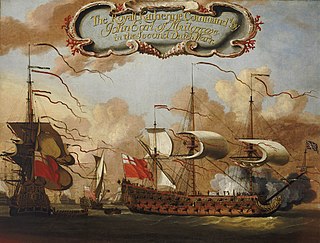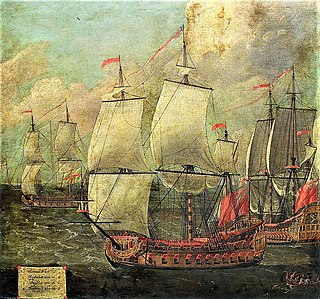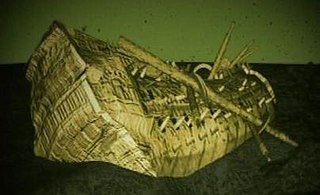
Royal Charles was an 80-gun first-rate three-decker ship of the line of the English Navy. She was built by Peter Pett and launched at Woolwich Dockyard in 1655, for the navy of the Commonwealth of England. She was originally called Naseby, named in honour of Sir Thomas Fairfax's decisive 1645 victory over the Royalist forces during the English Civil Wars. She was ordered in 1654 as one of a programme of four second rates, intended to carry 60 guns each. However, she was altered during construction to mount a complete battery of guns along the upper deck, and so was reclassed as a first rate.

HMS Royal Katherine was an 84-gun full-rigged second-rate ship of the line of the Royal Navy, launched in 1664 at Woolwich Dockyard. Her launching was conducted by Charles II and attended by Samuel Pepys. Royal Katherine fought in both the Second and Third Anglo-Dutch Wars and afterwards, the War of the Grand Alliance before entering the dockyard at Portsmouth for rebuilding in 1702. In this rebuilding, she was upgraded to carry more guns, 90 in total, and served in the War of the Spanish Succession during which she was renamed Ramillies in honour of John Churchill's victory at the Battle of Ramillies. She was rebuilt again in 1742–3 before serving as the flagship of the ill-fated Admiral John Byng in the Seven Years' War. Ramillies was wrecked at Bolt Tail near Hope Cove on 15 February 1760.

HMS Indus was an 80-gun two-deck second-rate ship of the line of the Royal Navy, launched on 16 March 1839 at Portsmouth Dockyard.

HMS Invincible was a 74-gun third-rate ship of the line of the Royal Navy, launched on 9 March 1765 at Deptford. Invincible was built during a period of peace to replace ships worn out in the recently concluded Seven Years' War. The ship went on to serve in the American War of Independence. May, 1778 under command of Capt. Anthony Parry. Fought at the battles of Cape St Vincent in 1780, and under the command of Captain Charles Saxton, the Battles of the Chesapeake in 1781 and St Kitts in 1782.

HMS Agincourt was a 74-gun third-rate ship of the line of the Royal Navy, launched on 19 March 1817 at Devonport.
HMS Royal Oak was a 100-gun first rate ship of the line of the Royal Navy, launched in 1664 at Portsmouth Dockyard. Royal Oak was built by John Tippetts, Master-Shipwright at Portsmouth 1660-8, who later became Navy Commissioner and subsequently Surveyor of the Navy.
HMS Rupert was a 64-gun third rate ship of the line of the Royal Navy, launched at Harwich Dockyard on 26 January 1666 and broken up in 1769.
HMS Defiance was a 64-gun third rate ship of the line of the English Royal Navy, ordered on 26 October 1664 under the new construction programme of that year, and launched on 27 March 1666 at William Castle's private shipyard at Deptford in the presence of King Charles II.
Francis Baylie was a shipbuilder based in Bristol, England, during the 17th century, a well established merchant shipbuilder who also built warships for the English Royal Navy.

HMS St Michael was a 90-gun second rate ship of the line of the Royal Navy, built by John Tippetts of Portsmouth Dockyard and launched in 1669.

HMS Edgar was a 72-gun third rate ship of the line of the Royal Navy, built by Baylie of Bristol and launched in 1668. The diarist and naval administrator Samuel Pepys visited the town during its construction, noting that in his opinion, "it will be a fine ship". By 1685 she was carrying 74 guns.

Kingfisher was a 46-gun fourth-rate ship of the line of the Royal Navy, built by Phineas Pett III at Woolwich Dockyard and launched in 1675. She was specially designed to counter the attacks of Algerine corsairs, or pirates, in the Mediterranean by masquerading as a merchantman, which she achieved by hiding her armament behind false bulkheads. She also was provided with various means of changing her appearance.

Constant Warwick was originally a 32-gun privateer, built in 1645 as a private venture between the Earl of Warwick and Sir William Batten and intended to operate as a privateer. Hired for service in the Parliamentarian navy during the First English Civil War, her captain William Batten defected to the Royalists during the 1648 Second English Civil War. After her crew mutinied in November 1648, she returned to England and was purchased by Parliament for the Commonwealth Navy on 20 January 1649. Described as an "incomparable sailer", she was noted for her sharpness and fine lines, and is considered by some as the first true frigate of the Royal Navy. Mainly used for patrolling, she was captured by the French in 1691.

HMS Assurance was a 32-gun fourth-rate of the English Navy, built by Peter Pett I at Deptford Dockyard and launched in 1646. She was in the Parliamentary force during the English Civil War, then the Commonwealth Navy and was incorporated into the Royal Navy after the Restoration in 1660. During her time in the Commonwealth Navy she partook in the Battles of Dover, Portland, Gabbard and Texel. She foundered in a gale at Woolwich in 1660 and was salved. After the Restoration she partook in the Battle of Lowestoffe, the Four Days Fight and the Texel (1673). She was reduced to a Fifth Rate in 1690 before being sold in 1698.

HMS Adventure was a 34-gun fourth-rate of the English Navy, built by Peter Pett II at Woolwich Dockyard and launched in 1646. With the outbreak of the English Civil War she served on the Parliamentary side until 1649. She was incorporated into the Commonwealth Navy in 1650. She partook in the Battle off Dover in 1652, the Battle of Portland and the Battle of Gabbard in 1653. Adventure was employed on Bulstrode Whitelocke's embassy to Sweden, 1653–1654. After the Restoration she was incorporated into the Royal Navy. She was present at the Battle of Lowestoft (1665) and the Battle of Solebay (1672). She also participated in the Golden Horse and Two Lions actions in 1681. She was in the Battle of Barfleur in 1692. She captured several ships in the later part of her career, before being captured by the French in 1709.
Gainsborough was a 40-gun fourth-rate frigate of the English Navy, originally built under the 1652 programme for the navy of the Commonwealth of England by Thomas Taylor at Pitch House (Wapping), and launched in 1653. She was named for the Parliamentarian victory at the Battle of Gainsborough in 1643.

The Maidstone was a 40-gun fourth-rate frigate of the English Royal Navy, originally built for the navy of the Commonwealth of England at Woodbridge, and launched in 1654.

London was a 76-gun second-rate ship of the line in the Navy of the Commonwealth of England, originally built at Chatham Dockyard by shipwright John Taylor, and launched in June 1656. She gained fame as one of the ships that escorted Charles II from Holland back to England during the English Restoration, carrying Charles' younger brother James Duke of York, and commanded by Captain John Lawson.
HMS Saudadoes was built by Anthony Deane after his transfer to Portsmouth Dockyard as the Master Shipwright. She was a smaller version of the Greyhound design. Initially she was a 8/6-gun sixth rate vessel. She was rebuilt in 1673 as a standard 16-gun vessel. She was commissioned in November 1669 then taken in hand at Deptford for her rebuild. She spent the majority of her career in Home Waters, participating in the Battle of Bantry Bay and the Battle of Barfleur. She went to the Mediterranean for a year in 1694. Her final service was in the Channel where she was captured by two French privateers and burnt in February 1696.
HMS Jersey was a member of the standardized 20-gun sixth rates built at the end of the 17th century. After commissioning she spent most of her career in the West Indies. She was wrecked there in October 1707.













